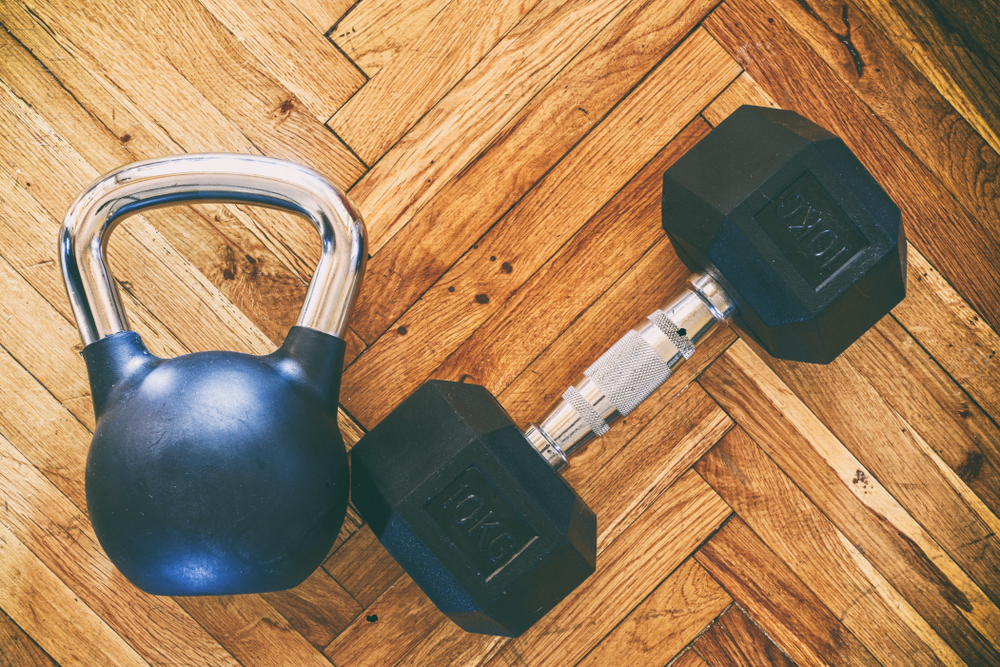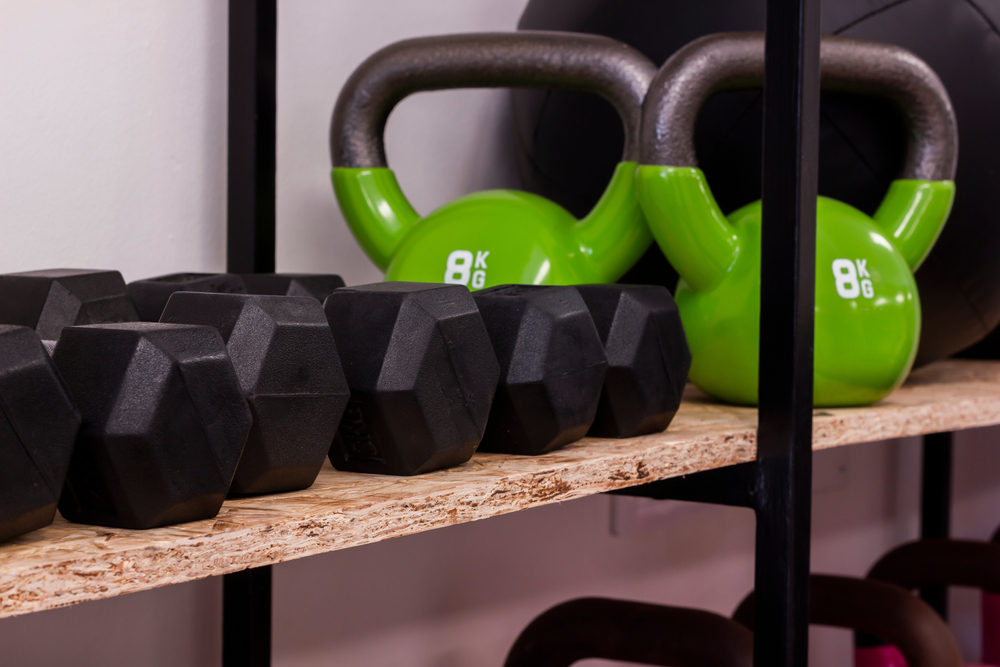You've probably wondered whether dumbbells or kettlebells deliver better results for your fitness goals.
The answer depends on what you're trying to achieve: dumbbells excel at building raw strength and muscle mass through isolation exercises, while kettlebells dominate for explosive power, calorie burning, and functional movement patterns.
Keep reading for the complete research-backed breakdown that will help you make the right choice for your specific training objectives.
Physical Design Differences That Impact Your Workout
The structural differences between dumbbells and kettlebells create entirely different training experiences.
When you pick up a dumbbell, you're holding a short bar with weight plates at both ends, which places the center of mass directly in your palm between the two weight sections.
This balanced design gives you stable control during movements like bicep curls or shoulder presses.
Kettlebells flip this concept completely.
The weight sits concentrated below your palm, resting on the outside of your wrist and forearm like a cannonball attached to a handle.
This offset center of gravity means the weight constantly wants to pull away from your body, forcing your stabilizing muscles to work harder throughout every movement.
Handle thickness plays a bigger role than most people realize.
Kettlebells typically feature much thicker handles compared to the narrow grip of dumbbells.
This design choice isn't accidental – the thicker surface area challenges your grip strength significantly more, turning every exercise into a forearm workout whether you planned it or not.
The grip versatility gives kettlebells another advantage.
While dumbbells accommodate only one hand per weight, kettlebell handles let you switch between single-handed and two-handed grips during the same exercise.
You can perform a kettlebell swing with both hands, then immediately transition to single-arm movements without switching equipment.
These design differences directly affect how your body moves and adapts during workouts.
The dumbbell's stable center of mass allows for precise, controlled movements that isolate specific muscles.
Meanwhile, the kettlebell's unstable weight distribution forces your entire kinetic chain to engage, creating more dynamic and unpredictable movement patterns that better mimic real-world activities.
Muscle Activation and Movement Science
The scientific data reveals fascinating differences in how your muscles respond to dumbbells versus kettlebells.
Research on kettlebell swings shows they create remarkable muscle activation levels – reaching 50% of maximum voluntary contraction for your low back extensors and an impressive 80% for your gluteal muscles when using just a 16kg kettlebell.
These numbers demonstrate why kettlebell training feels so demanding even with relatively light weights.
EMG studies comparing overhead pressing movements tell a different story.
When researchers measured muscle activity during seated dumbbell versus kettlebell overhead presses using equal loads, the dumbbell version produced slightly higher anterior deltoid activation.
This suggests that for targeting specific shoulder muscles, dumbbells might give you a small edge in muscle recruitment.
A 2013 Danish study uncovered something interesting about hamstring activation patterns.
Kettlebell swings preferentially activate the medial hamstring muscle (semitendinosus) more than the lateral hamstring (biceps femoris).
This selective activation pattern could be valuable for addressing muscle imbalances or targeting specific areas of hamstring development.
Biomechanical modeling has identified unique forces that kettlebell movements place on your spine.
The dynamic nature of kettlebell swings creates distinctive posterior shear forces in the lumbar spine that don't occur with traditional dumbbell exercises.
This isn't necessarily problematic, but it highlights why proper form becomes absolutely critical with kettlebell training.
The movement patterns themselves differ fundamentally between the two tools.
Kettlebell exercises like swings create rapid muscle activation-relaxation cycles within hip-hinge squat patterns.
Your muscles fire intensely, then quickly relax, then fire again in rapid succession.
This creates a completely different neuromuscular training stimulus compared to the steady, controlled contractions typical of dumbbell exercises.
Strength Building and Muscle Development Comparison
When it comes to building raw strength, the research delivers a clear verdict.
A comprehensive 2012 study compared strength gains between groups using kettlebells versus traditional barbell and dumbbell training, and the results were striking.
The barbell/dumbbell group achieved a 15% improvement in their squat maximum compared to just 5% for the kettlebell group – a threefold difference in strength gains.
The performance metrics paint a similar picture.
Participants using dumbbells and barbells saw their vertical leap ability increase by 4%, while the kettlebell group managed only a 1% improvement.
Overall strength increases followed the same pattern, with traditional weights producing 10% gains versus 4% for kettlebells.
These numbers suggest that if your primary goal is getting stronger in measurable ways, dumbbells hold a significant advantage.
The reason behind this difference lies in how each tool allows you to train.
Dumbbells excel at isolation exercises that let you target specific muscles with precision and progressive overload.
You can perform focused movements like chest flies, lateral raises, or tricep extensions that zero in on particular muscle groups.
This targeted approach allows for the kind of systematic strength building that shows up clearly in performance tests.
Kettlebells tell a different story when it comes to movement quality and functional strength.
While they may not produce the same raw strength numbers, they excel at explosive, compound movements that train your body as an integrated system.
The dynamic nature of kettlebell exercises develops the kind of functional strength and power that translates well to real-world activities and athletic performance.
The choice between these tools often comes down to your definition of strength.
If you want to move heavier weights and see bigger numbers on strength tests, dumbbells provide the more direct path.
If you're after functional strength that improves how your body moves and performs in complex, multi-joint patterns, kettlebells offer unique benefits that pure strength measurements might not capture.
Power Development and Athletic Performance Benefits

Kettlebells shine brightest when explosive power becomes the priority.
The simple act of “grabbing and swinging” a kettlebell creates movement dynamics that dumbbells simply can't replicate.
This ballistic training style teaches your body to generate force rapidly and efficiently, making it invaluable for athletes who need to produce power quickly in their sport.
A 2012 study published in the Journal of Strength & Conditioning Research provided scientific backing for what many coaches already suspected – kettlebell training represents a viable option for improving both maximal and explosive strength production.
The research demonstrated that kettlebell movements could enhance the kind of rapid force development that translates directly to athletic performance.
The biomechanical benefits extend far beyond simple strength gains.
Kettlebell training improves the coordination and timing between muscle groups, teaching your body to work as an integrated system rather than isolated parts.
This whole-body integration becomes particularly valuable for sports that require complex, multi-directional movements like basketball, soccer, or martial arts.
Athletic movement patterns share striking similarities with kettlebell exercises.
The hip-hinge motion of a kettlebell swing mirrors the mechanics of jumping, sprinting, and throwing.
When you train these patterns with kettlebells, you're essentially rehearsing the same movement qualities your body needs during competition.
This makes kettlebell training exceptionally effective for sports performance enhancement.
Dumbbells, while excellent for building strength, don't offer the same explosive training stimulus.
Their design favors controlled, deliberate movements that build muscle and strength but don't necessarily improve your ability to generate power quickly.
For athletes who need to jump higher, sprint faster, or change direction more explosively, kettlebells provide training adaptations that dumbbells struggle to match.
The functional strength developed through kettlebell training translates more directly to the dynamic demands of athletic performance.
Calorie Burn and Metabolic Impact Analysis
Kettlebells dominate the calorie-burning conversation with numbers that put most other training methods to shame.
During active training, kettlebell swings torch between 15-21 calories per minute – a rate that places this simple movement among the most metabolically demanding exercises you can perform.
For perspective, a 175-pound person can burn approximately 816 calories per hour through kettlebell intervals or continuous swinging.
The metabolic efficiency becomes even more impressive when compared to traditional cardio.
A 12-minute kettlebell circuit burns 145 calories while maintaining an average heart rate of 149 beats per minute.
Compare this to cycling sprints, which burned only 122 calories with a lower average heart rate of 140 bpm over the same duration.
The kettlebell workout delivered more calorie burn with higher cardiovascular demand in less time.
Perhaps most striking is the intensity comparison to running.
Research shows that a 20-minute kettlebell snatch workout burns calories at a rate equivalent to running at a “6-minute mile pace.
This comparison puts kettlebell training in elite athlete territory for caloric expenditure, yet requires no running surface, weather considerations, or joint impact concerns.
The metabolic benefits extend well beyond the workout itself through what scientists call EPOC – excess post-exercise oxygen consumption.
This “afterburn effect” means your body continues burning calories at an elevated rate for hours after your kettlebell session ends.
Your metabolism stays revved up as your body works to restore oxygen levels, clear metabolic byproducts, and repair muscle tissue.
Dumbbells, while effective for building muscle that increases long-term metabolic rate, can't match the immediate caloric impact of kettlebell training.
Traditional dumbbell exercises typically involve controlled movements with rest periods between sets, creating a different metabolic stimulus.
The continuous, dynamic nature of kettlebell movements keeps your heart rate elevated throughout the workout, maximizing both immediate calorie burn and post-exercise metabolic benefits.
Safety, Learning Curve, and Practical Training Applications
For beginners stepping into strength training, dumbbells offer a gentler introduction to free weights.
The even weight distribution creates predictable movement patterns that feel more natural and controllable compared to kettlebells' offset center of gravity.
This stability advantage means new trainees can focus on learning proper form without fighting against unpredictable weight shifts.
Safety considerations favor dumbbells in several scenarios.
During exercises like the chest press, if you reach muscle failure and can't complete the repetition, you can simply drop the weights and they'll fall harmlessly to the ground beside you.
Kettlebells present different challenges – their thicker handles and dynamic movements require constant grip control, making it harder to safely bail out of a movement if something goes wrong.
The grip strength demands of kettlebells work both for and against safety.
During swings, the momentum creates what trainers call “escape forces” – the kettlebell literally tries to fly out of your hands.
While this builds exceptional grip strength over time, it also increases the risk of losing control, especially for beginners or during high-repetition sets.
Research on elderly populations reveals kettlebells' therapeutic potential when used properly.
Studies on participants with sarcopenia showed significant improvements in the sarcopenia index, grip strength, back strength, and peak expiratory flow (PEF) after kettlebell training.
These results demonstrate that kettlebells can be valuable tools for combating age-related muscle loss, though proper instruction becomes even more critical with older adults.
The practical applications break down clearly along training goals.
Choose dumbbells when your focus is muscle building, isolation exercises, or learning fundamental movement patterns.
Kettlebells excel for explosive power development, cardiovascular conditioning, and functional movement training that mimics real-world activities.
Most fitness experts recommend incorporating both tools rather than choosing exclusively.
Dumbbells provide the foundation for strength and muscle development, while kettlebells add dynamic elements that improve power, coordination, and metabolic conditioning.
This combined approach gives you access to the unique benefits of each tool while minimizing their individual limitations.
Conclusion
The choice between dumbbells and kettlebells doesn't have to be either-or – each tool excels in different areas of fitness development.
Dumbbells deliver superior results for building raw strength and muscle mass through controlled, isolated movements, while kettlebells dominate explosive power training, calorie burning, and functional movement patterns.
For the best results, incorporate both tools strategically based on your specific goals rather than limiting yourself to just one option.







